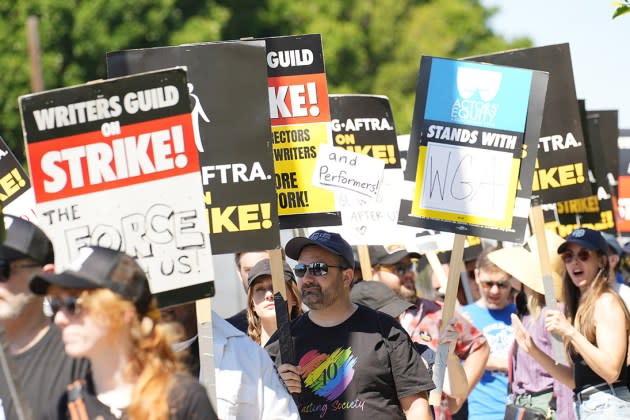SAG-AFTRA’s Controversial Interim Agreements Rescue — and Baffle — Indie Producers
- Oops!Something went wrong.Please try again later.
- Oops!Something went wrong.Please try again later.
- Oops!Something went wrong.Please try again later.

When Exhibiting Forgiveness, the first movie from African-American painter Titus Kaphar, started shooting in New Jersey in June, producers of the independent film were bracing themselves for a potential SAG-AFTRA strike.
“We started with our fingers crossed,” says producer Jamie Patricof of the movie, which stars a cast of as-yet unannounced SAG actors, including at least one Oscar nominee.
More from The Hollywood Reporter
Nicolas Cage's 'Dream Scenario' to Open Toronto Film Fest Platform Competition
How the Strikes Could Impact the Film Academy's Museum Gala, Governors Awards and Oscars
The producers, including Producers Guild president Stephanie Allain and Blue Valentine director Derek Cianfrance, stayed in close touch with their SAG rep as talks between the actors’ union and the Alliance of Motion Picture Television Producers continued over the next month and hired a labor attorney to help them navigate the system. When SAG officially called the strike on July 13, Exhibiting Forgiveness had five days left of shooting, and the movie became among the first productions to apply for and receive one of the guild’s interim agreements.
“If we hadn’t done it, the film would have just gone away,” Patricof says. “We were desperate. I hope I didn’t agree to giving away my first born, but I might have.”
SAG has now approved more than 100 of these agreements, which allow productions to proceed if they comply with SAG’s terms, and its contracts department is reviewing hundreds more. For the independent producers who sign them, the agreements are a lifeline, but confusing, and a little scary to sign.
Smaller studios that are not part of the AMPTP, including Lionsgate, A24 and Neon, are eligible, as are independently financed films.
Projects that have received interim agreements so far include the Kevin Costner-produced The Gray House, Ishana Night Shyamalan’s The Watchers, and A24’s Death of a Unicorn.
The terms of the agreements, which are laid out in a 70-page document based largely on the union’s last counter offer to the studios before talks broke down, include an 11 percent raise in the minimum pay for actors, a 23 percent raise for stunt performers, increased contributions to health and pension funds, demands for revenue sharing and guidelines around the use of artificial intelligence.
The interim agreements have become a lightning rod on social media for some in Hollywood who think they violate the spirit of the strike—Sarah Silverman shared a video declaring herself “pissed off” by them. SAG, however, has called the agreements, “a vital part of our strategic approach,” and said indie producers’ appetite to sign up for them is evidence that the contract terms the AMPTP rejected, “are in fact reasonable and appropriate.”
“Leading up to the strike, independent films had largely ground to a halt because no one could get completion bonds,” says one producer who obtained an interim agreement for a film that was in production when the strike began. “We rolled the dice hoping SAG wouldn’t strike, and while the strike and subsequent shutdown really hurt, we are lucky we get to finish.”
When SAG and the AMPTP finally do arrive at a deal, that contract will supersede the interim agreements. To the producers who are obtaining these agreements, it’s confusing what that means to them. What’s unclear, says a producer who has obtained an interim agreement, is “what rates apply when, to whom, and how a true-up will actually happen once a broader deal gets done.” If the ultimate deal the studios reach with SAG is less generous than the interim agreements, which seems likely, this producer says, “The odds that you claw back anything that you’ve already paid out are slim.”
There is also the issue of selling movies made under interim agreements once they’re finished. “Will Apple, Netflix or Focus buy a film that has signed an interim agreement?” asks the producer. ‘Some [distributors] have said they’re buying, especially with few films being made right now; some are going through legal review. If distributors won’t buy content made on the interim agreement, no one will sign them.”
And just because a producer or company obtains one of the agreements, that doesn’t mean talent will want to take advantage of it. “It remains to be seen what each individual artist’s decision is going to be,” says an executive at a non-AMPTP company.
On July 29, Viola Davis announced that she was stepping away from the MRC film G20, which was set to be distributed by Amazon (MRC is not a member of the AMPTP, but Amazon is). SAG-AFTRA granted the film an interim agreement, in part because it was set to shoot in South Africa. But Davis said in a statement that, “I do not feel that it would be appropriate for this production to move forward during the strike.”
Multiple independent producers expressed their confusion about the Davis film getting an interim agreement in the first place, given that Amazon is its distributor; there is also consternation about the AppleTV+ show Tehran, a spy thriller shot in Israel, obtaining one. SAG has said that projects in progress in certain foreign countries must honor labor laws there pertaining to the timing of strikes.
Some indie producers navigating the complex strike landscape are hopeful the agreements will ultimately help boost what is a challenging business in the best of times.
“I’m a union girl,” says Allain, who is also a member of the WGA. “I’m supportive. We’re following the rules. All the time and effort to get an indie made these days—wouldn’t it be great if the independent world could actually thrive right now?”
Additional reporting by Katie Kilkenny.
Best of The Hollywood Reporter
